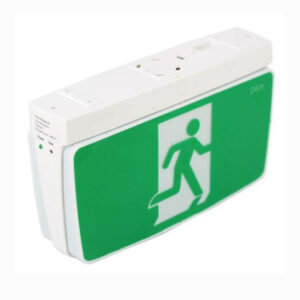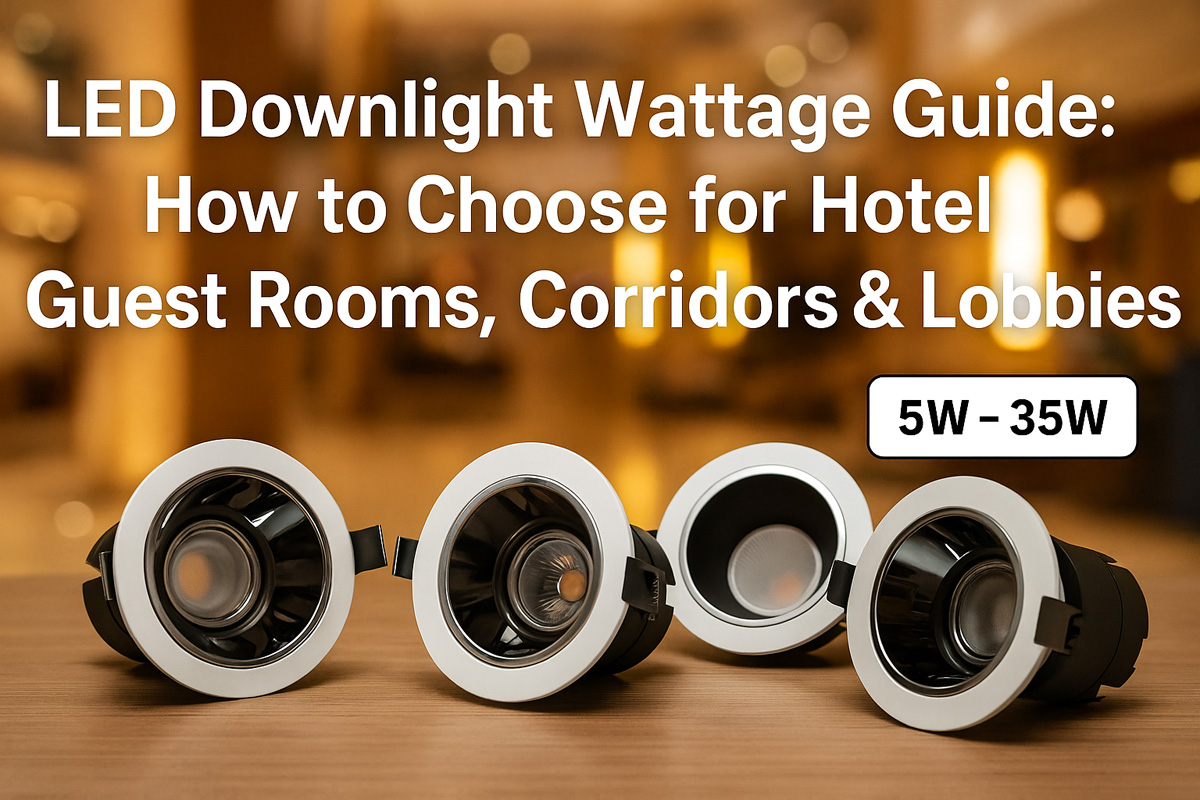
In the hotel industry, safety constantly takes center stage. Thus, emergency lighting plays an essential part in the guests’ well-being. While emergency lights might not be the stars of individual hotel bedrooms, they step into the limelight in communal spaces and escape routes, ensuring a safe passage during unexpected power hiccups.
In this article, we’ll embark on a journey through the twists and turns of emergency lighting regulations, unraveling the must-know standards for hotels. After all, it’s not just about ticking the compliance boxes; it’s about creating a safe haven for hotel guests and streamlining evacuation with the right LED light fixtures.
General Emergency Lighting Regulations for Hotels
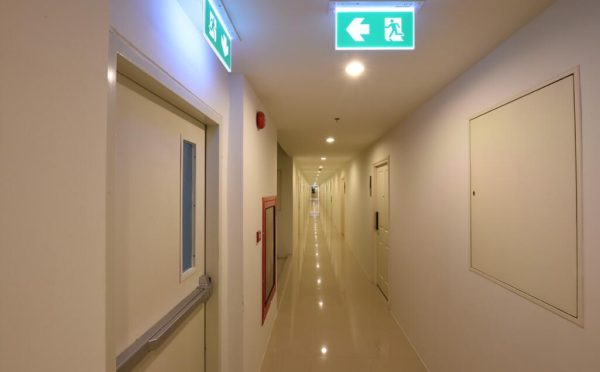
In the hospitality sector, ensuring the well-being of guests takes precedence, and adherence to emergency lighting regulations is a crucial component of this dedication.
While specific regulations may vary by country, there are overarching principles that generally apply to hotels worldwide:
● NFPA 101 (National Fire Protection Association) Standards

The National Fire Protection Association (NFPA) is a globally recognized authority on fire safety. NFPA 101, the Life Safety Code, provides comprehensive guidelines for emergency lighting in hotels. It stipulates that emergency lighting must illuminate all exit routes, exit signs, and areas with critical equipment, ensuring safe egress during power outages or emergencies.
Regular testing and maintenance are emphasized to guarantee the functionality of emergency lighting systems when needed.
● Illumination Intensity Requirements

Emergency lighting is mandated to meet specific illumination intensity levels to ensure visibility in various areas. For example, in corridors, stairwells, and other escape routes, the minimum illumination levels are specified to guide occupants safely. This ensures that even in complete darkness, guests can confidently navigate these spaces.
The optimal color temperature and brightness level for emergency lighting in hotels can vary based on factors such as the specific areas within the hotel and local regulations. However, a common recommendation is to use cool white light with a color temperature ranging between 5000K and 6500K for emergency lighting. This color temperature provides clear visibility and enhances the perception of safety.
As for brightness, emergency lighting in hotels is often designed to achieve a minimum illuminance level of 1 lux in designated escape routes and other critical areas during a power outage. Lux is a unit of measurement for illuminance, representing the amount of light falling on a surface.
● Periodic Testing and Maintenance
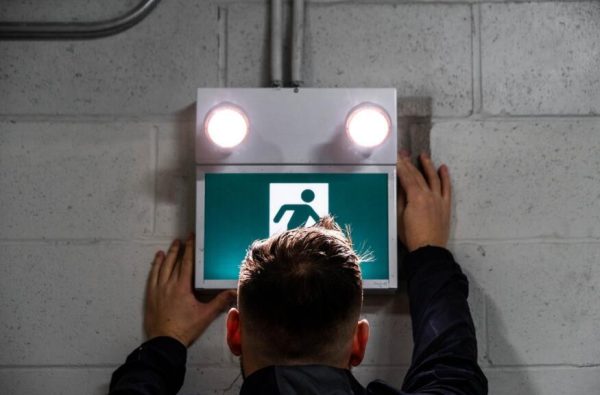
Regular testing and maintenance are fundamental requirements for emergency lighting systems in hotels. The intervals for testing are often specified, and hotel owners must ensure that the system undergoes routine checks. This includes functionality tests, battery inspections, and verification of illumination levels.
● Exit Signage Standards

Emergency exit signs are a crucial component of a hotel’s safety infrastructure, hence they are the common partner of emergency lights. Regulations dictate that exit signs must be clearly visible, adequately illuminated, and positioned to guide occupants along the safest egress route. Regular inspections are required to confirm the functionality and visibility of these signs.
● Backup Power Requirements
Emergency lighting systems are often required to have a reliable backup power source to ensure continuous operation during power failures. This could include battery-powered lights or generators, guaranteeing that the emergency lighting remains functional for an extended period.
● Accessibility Considerations
Emergency lighting regulations often address the accessibility of emergency exits and lighting for all occupants, including those with disabilities. Clear pathways, visual and audible signals, and appropriate lighting for diverse needs are crucial aspects considered in these regulations.
● Record-Keeping Obligations
Hotels are typically obligated to maintain records of emergency lighting inspections, tests, and any corrective actions taken. This documentation not only serves as evidence of compliance but also aids in identifying potential issues and addressing them proactively.
Understanding these general regulations is fundamental for hotel owners and managers, providing a solid foundation for creating a safe environment that complies with international safety standards.
How Emergency Lighting Enhances Comfort and Confidence

Apart from the strict adherence to regulations, the installation of effective emergency lighting in hotels brings a myriad of benefits that extend far beyond safety protocol. Guests, often unaware of the meticulous planning behind emergency lighting, experience enhanced comfort and heightened confidence in the hotel’s commitment to their well-being.
Imagine a power outage. The sudden plunge into darkness can be disorienting and unsettling. However, well-placed emergency lights instantly come to life, casting a gentle glow along corridors and stairwells. This not only illuminates the path to safety but also provides a calming effect, preventing panic among guests. In these moments, emergency lighting transforms from a regulatory requirement to a source of comfort, ensuring a smooth and stress-free evacuation process.
The subtle illumination from emergency lights is designed not to disrupt the ambiance of a hotel’s design. Instead, it becomes an integral part of the environment, seamlessly integrated into the aesthetic. This careful balance between functionality and design contributes to an overall positive guest experience, where safety measures are implemented without compromising the welcoming atmosphere.
Furthermore, guests, often unknowingly, seek cues about a hotel’s commitment to their safety and well-being. Visible emergency lights, strategically positioned and well-maintained, send a powerful message.
Indeed, the presence of emergency lighting conveys a sense of responsibility and preparedness, instilling confidence in the establishment. Guests feel secure in the knowledge that the hotel has not only met regulatory standards but has gone above and beyond to ensure their safety.
This heightened confidence in a hotel’s safety measures translates into a positive guest perception and, ultimately, customer loyalty. Guests are more likely to return to a hotel where they feel secure and cared for during unexpected situations.
In the age of online reviews and social media, positive experiences related to safety contribute to a hotel’s reputation, attracting more guests and solidifying its standing in the competitive hospitality landscape.
Exploring the Latest Innovations in Hotel Emergency Lighting
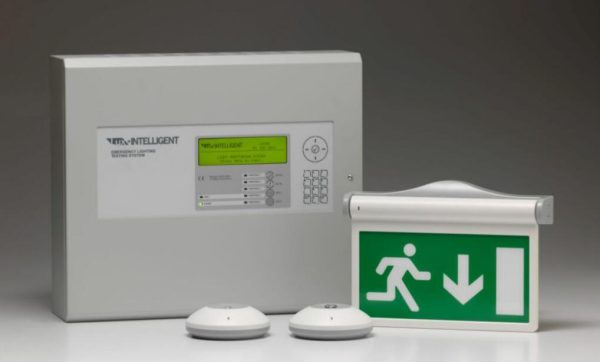
The latest innovations in hotel emergency lighting reflect advancements in technology, efficiency, and sustainability. Some notable innovations include:
- Smart Emergency Lighting Systems. Integration of smart technology with emergency lighting systems allows for real-time monitoring and control. Sensors can detect power outages, occupancy levels, and environmental conditions, ensuring a prompt and tailored response during emergencies.
Energy-Efficient Backup Power Solutions. Innovations in battery technology enhance backup power solutions. Lithium-ion batteries, for instance, offer longer lifespans and higher energy density, ensuring prolonged functionality during power outages without compromising safety.
- Wireless Connectivity. Wireless communication enables seamless connectivity between emergency lighting systems, allowing for centralized monitoring and control. This facilitates easier maintenance, testing, and updates, enhancing the overall efficiency of emergency lighting management.
- Occupancy Sensing and Wayfinding.Emergency lights equipped with occupancy sensors can adjust brightness levels based on the number of people in a specific area, optimizing energy usage. Wayfinding features use visual cues to guide occupants along the safest evacuation routes, reducing panic during emergencies.
- Solar-Powered Emergency Lights.Sustainability is a growing focus in the hospitality industry. Solar-powered emergency lights harness renewable energy, reducing dependency on traditional power sources. These lights charge during daylight hours and provide illumination during nighttime power failures.
Selecting the Right LED Lighting for Hotel Emergency Lights

Selecting the right LED fixtures for your hotel’s emergency lighting involves a thoughtful, step-by-step approach to ensure both functionality and aesthetic harmony.
Assess Your Spaces
Begin by identifying the specific areas within your hotel that require emergency lighting. Corridors, stairwells, and exits are key focus areas. Understanding the unique lighting needs of each space is the foundation for an effective selection process.
Know Your Local Regulations
Familiarize yourself with local regulations governing emergency lighting. Each region may have specific requirements regarding color temperature, brightness levels, and fixture types. Ensure your choices align with these standards to guarantee compliance.
Consider Color Temperature
Optimal color temperature significantly impacts visibility and ambiance. For emergency lighting, a cool white light ranging between 5000K and 6500K is generally recommended. This color temperature ensures clear visibility and enhances the perception of safety without being harsh on the eyes.
Adjustable Brightness Levels
Look for fixtures with adjustable brightness levels. Different areas may require varying illuminance levels. Fixtures with adjustable settings provide flexibility to meet these diverse needs, ensuring optimal visibility without unnecessary glare.
Harmony with Design
Balance functionality with design aesthetics. Choose fixtures that seamlessly integrate into your hotel’s design without compromising safety. LED fixtures come in various styles, ensuring you can find options that complement the overall ambiance, maintaining a welcoming atmosphere even during emergencies.
Prioritize Reliable Brands
Opt for LED fixtures from reputable and reliable brands. Trustworthy brands such as AiDiWatt Lighting have a track record of quality and adherence to safety standards. Reading reviews and seeking recommendations can provide valuable insights into the performance and durability of different fixtures.
Final Thoughts
In the delicate balance between safety and hospitality, emergency lighting plays the role of a vigilant protector, boosting guest assurance and overall well-being.
Understanding and implementing emergency lighting regulations is not merely a compliance checkbox—it’s the heartbeat of guest well-being. Hotels that wholeheartedly embrace these regulations don’t just fulfill standards; they construct a haven of safety and confidence.
So, for our beloved hotel owners or lighting companies that supply lighting for hotels, we hope you strictly apply the emergency lighting regulations and simultaneously create a vibe where guests feel safe and secure. Because, in the end, it’s not just a hotel; it’s a home away from home.

